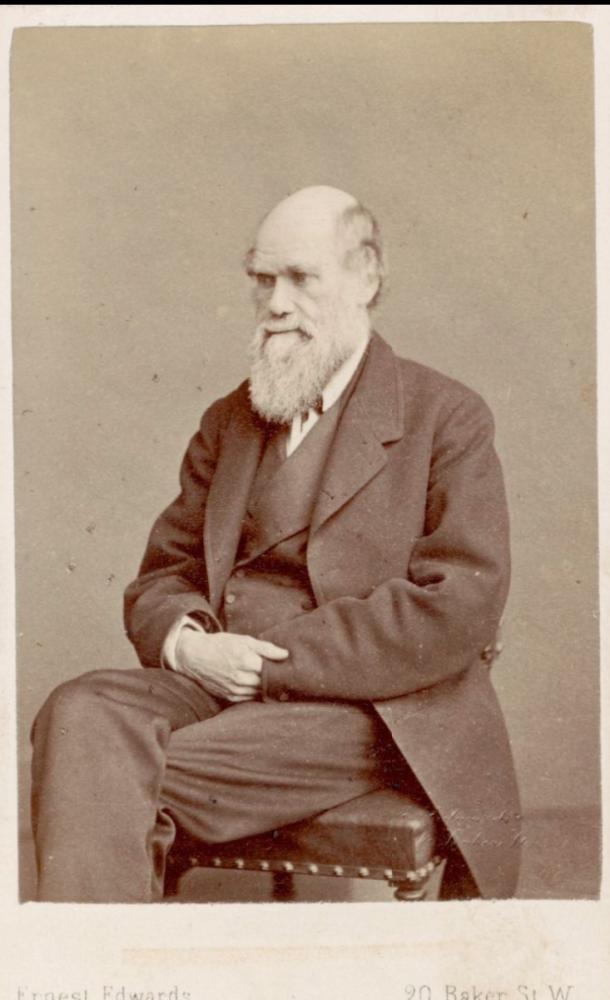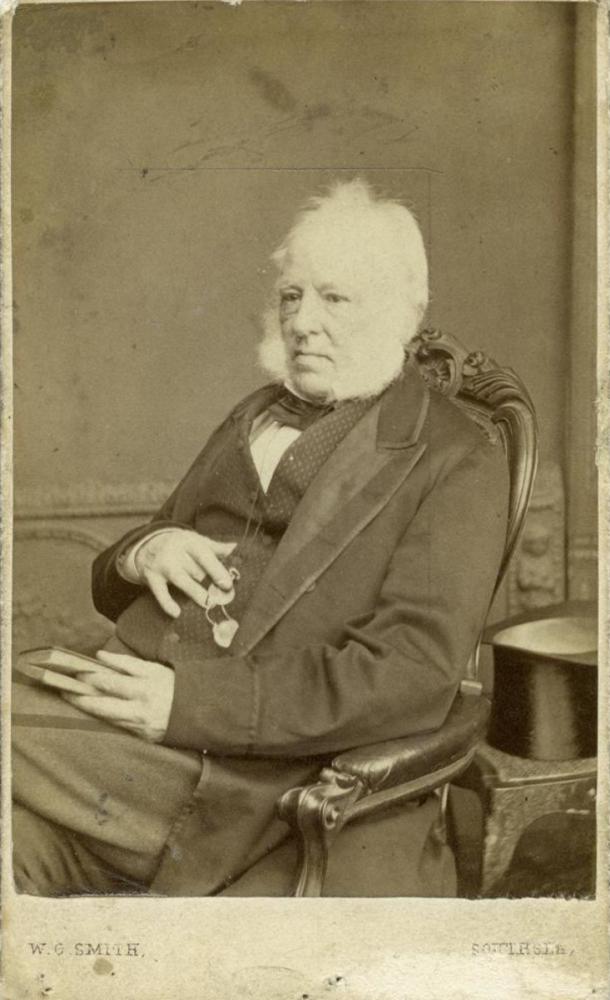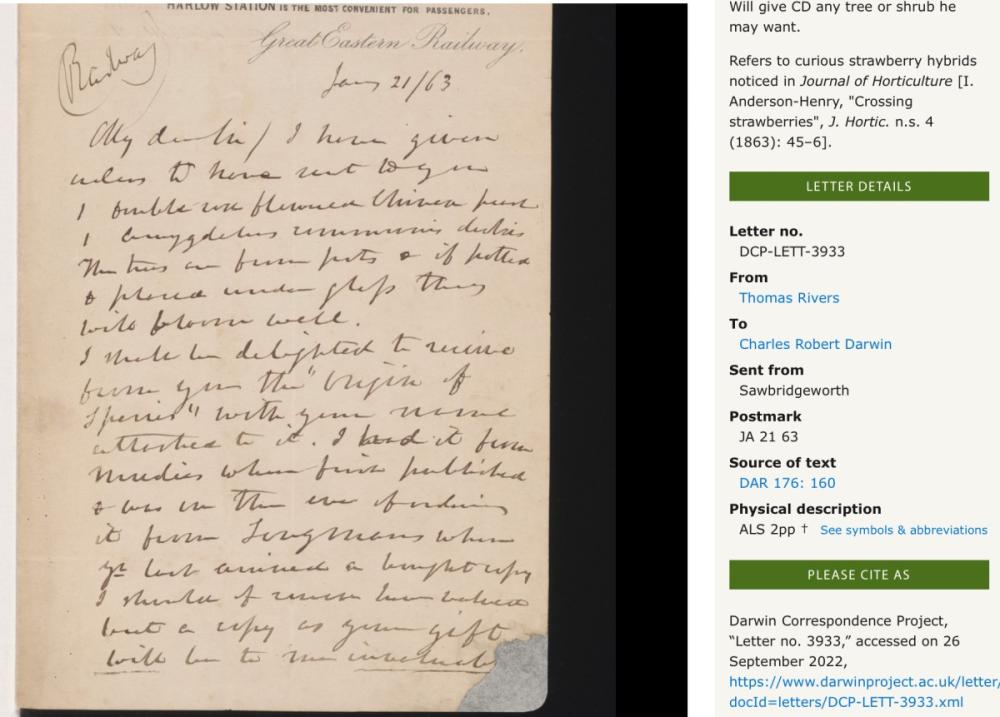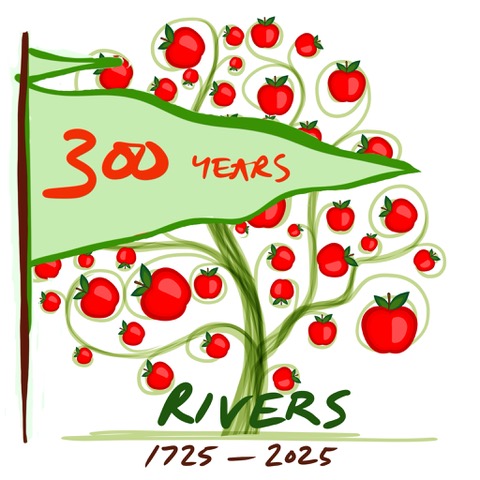Thomas Rivers and Charles Darwin: Cartes de Visite in the Lindley Library
Written by Elizabeth Waugh
Published on July 1, 2025.
Return to the contents page.
 |
 |
| Charles Darwin, Carte de Visite, Lindley Library. | Thomas Rivers, Carte de Visite, Lindley Library. |
In the balmy month of May, the Royal Horticultural Society Chelsea Flower Show unfolded night after night on our television screens, always an inspiring pageant. It is interesting during Rivers Nursery’s 300th year to trace RHS records which show that Thomas Rivers of Sawbridgeworth makes a contribution to the development of the Society, and to Britain’s international reputation for outstanding horticulture.
The Royal Horticultural Society was founded in London on 7 March 1804 at a meeting of seven men. The Society was dedicated to ‘the improvement and practice of horticulture’ and aimed ‘to introduce a scientific and evidence-based approach’ and to enable the sharing of knowledge. It was a ‘small, learned society of enthusiasts, professional gardeners and nurserymen.’ It was like a gentleman’s club: the fees were high and members were necessarily wealthy, and a nomination was required for membership to be considered. Though originally excluded, women have been admitted since 1830. The present Director General of the RHS is a woman as was her predecessor.
Continuing traditions were established from the beginning. An original founder, Joseph Banks, was a plant collector, and the Society quickly found a growing ground where collected specimens from around the world could be studied and developed. The royal connection was formally established when in 1858 Prince Albert became Society president. Reference books, horticultural journals and other kinds of information such as specimens were gathered. The RHS Lindley library was formally established in 1866 based on the private library of John Lindley, Society secretary - and editor of The Gardeners’ Chronicle which published many articles by and about Thomas Rivers - and by adding other reference materials that had already been collected. The Lindley is now the largest horticultural library in the world. In addition, each of the five RHS gardens today also has its own library. (See The History of the Royal Horticultural Society www.rhs.org.uk)
The RHS Lindley Library: Cartes-de-Visite
One of the many interesting collections held in the Lindley Library is their Cartes de Visite. This collection is described as ‘an unrivalled source of otherwise unobtainable portraits of nurserymen, garden designers, professional gardeners, botanists’ … and others in the field. Among the 700 is one for Thomas Rivers, 1798 -1877, the most successful of the Rivers Nursery directors.
It had become fashionable in the latter half of the nineteenth century for prominent individuals to have something like a calling card made with photograph. These were kept to give to those they visited or to be given to visitors to their homes or businesses. People began to make collections of such cards, much as people in more recent times have made books of celebrity signatures.
One such portrait card, a Carte de Visite of Thomas Rivers, came into the Lindley from the collection of Richard Dean, a horticultural journalist. He may have visited the Sawbridgeworth Nursery grounds as did many others who then wrote articles about what they saw. This Carte depicts Rivers in 1870, in Victorian pose, distinguished and prosperous. At the time, he was vice-chairman of the RHS Fruit and Vegetable Committee. This portrait, taken by W. G. Smith, is in the style of contemporary portrait photography of this type and measures 10.4 h x 6.2 w cm. From our knowledge of Rivers’ growing methods, we see the spirit of the times, shared with other distinguished RHS fellow gardeners, in his confident continuing quest for the new and his scientific approach.
These characteristics are also displayed in his correspondence with Darwin who was himself a founder of the RHS Science and Horticultural Advice Committee. There is a Carte de Visite of Darwin too, taken in 1866 by Ernest Edwards, measuring 10.3 x 6.3 cm. Although in the cordial letters between Rivers and Darwin, begun in 1862 and continuing until 1872, there is no reference to their joint membership of the RHS, it seems obvious that in reading journals of the time or in Committee minutes each would have known of the other and had a basis for respect of the other’s insights. Darwin had a reputation for humility as well as creative thinking. This quality of polite respect as well as the drive to learn shows in both sides of the Rivers/Darwin correspondence.
In addition to a Carte de Visite, the Lindley Library has volumes of RHS Council Minutes with references to Rivers’ participation, such as this note from 17 March 1868, ‘Rivers donates fruit trees for Soldiers’. We see him playing his part in the national conversation about horticulture.
Although Thomas Francis Rivers, son of the third Thomas, is mentioned in the Lindley archives, his name appears far less than his father’s. Frank seems to have been more down to earth and more a local dignitary than a national name.
The Lindley also holds a collection of Rivers catalogues, from 1912 - 1982, with gaps.
Visiting the Lindley Library with Rivers in mind is a great experience. To access particular items it is best to call in advance. However, there are such fascinating materials available on the shelves that even to go to look around without ordering anything specific is rewarding. Upstairs are the changing exhibits for visitors; downstairs is the access to Archives. All around Vincent Square, the library’s home in London, are the RHS horticultural halls for exhibitions. There is a comfortable sense of past achievements that merges into living history. The RHS is one of Britain’s great institutions, formed from the joint endeavour of local horticultural leaders working together, then and now.
See the entire list of Cartes de Visite and Committee Minutes at catalogue.rhs.org.uk.
 |
| Letter from Thomas Rivers to Charles Darwin, in response to Darwin’s enquiry, Jan. 21, 1863. Image taken from the Darwin Project, University of Cambridge. |
Elizabeth Waugh - June 2025
See also the following interesting article concerning Darwin and the horticultural press - which published articles by Rivers as we know - during the mid- nineteenth century: Brent Elliott, The reception of Charles Darwin in the British horticultural press in Occasional Papers from the RHS Lindley Library, 3: 5-83 (2010).
Return to the contents page.

